The past few weeks, we have talked about the importance of eating a wide variety of plants, including LOTS of vegetables and fruits. Plus, legumes, nuts, seeds, whole grains, herbs and spices!
There are many underappreciated and underutilized vegetables that just don’t get a chance to shine in our kitchens.
We want to shine the light on one of those today…
it’s fennel!
Believe it or not, fennel can add amazing, fresh flavor to a meal. And we know what you may be thinking…in our opinion it does NOT taste like black licorice! It’s delicious raw, especially when incorporated into salads with other flavors. When cooked, it turns tender and sweet and there are many fantastic ways to enjoy it!
Even if we didn’t realize it at the time, we have probably all enjoyed fennel as part of a delicious restaurant meal…so, we want to help show you how to bring its flavor and nutrition into your kitchen!
One of our favorite ways to enjoy fennel is in the Sweet Orange Roasted Fennel and Radish Salad – watch this video to see how easy it is to prepare!
What is fennel?
Fennel belongs to the same vegetable family as parsley, carrots, dill and coriander (or cilantro). It’s made up of a white or pale green bulb, with stalks topped with feathery green leaves, called fronds. These feathery leaves may look very similar to fresh dill, but their taste is different. The bulb, stalks, leaves and seeds are all edible.
Especially popular in Mediterranean and Italian cuisines, the bulb’s texture is similar to celery…some would say it is like a cross between an onion and celery. Fennel is available in grocery stores year-round and you can also look for it at your farmers’ markets in the spring and fall. You typically won’t see it in the middle of summer at your farmers’ markets because it doesn’t do well in the scorching heat. With its unique hint of anise flavor, some say it has a black licorice-like taste. In our experience, fennel does NOT taste like licorice, but instead provides a light, crunchy spring-like quality. When you cook it, the flavor turns mild and sweet.
Some may think leeks and fennel are related. While they are both used in Mediterranean cuisine, they are actually from two different vegetable families and provide different flavors. Leeks are part of the onion family and look like large thick green onions.
Why fennel?
Like many other vegetables, fennel is loaded with antioxidants, and includes an aromatic compound call anethole, which is found widely in nature in essential oils. Anethole contributes to its unique flavor. This important nutrient has been shown to reduce inflammation and help stop the spread of cancer. Fennel is also an excellent source of Vitamin C and is a good source of fiber, folate and potassium (which helps lower high blood pressure).
How do you choose it?
 When selecting fennel, you want to look for bulbs that are white or pale green. The stalks and leaves should be green, with a fragrant aroma. The bulbs come in various sizes…a typical size is about the size of a tennis ball.
When selecting fennel, you want to look for bulbs that are white or pale green. The stalks and leaves should be green, with a fragrant aroma. The bulbs come in various sizes…a typical size is about the size of a tennis ball.
Avoid bulbs that are split or cracked, or have discoloration or bruising. You don’t want there to be flowering buds on the fennel, which means it has passed its optimum maturity.
How do you store it?
It’s ideal to store fennel bulbs in the refrigerator. They will last for 7-10 days, especially if they were recently harvested and purchased at a local farmers’ market.
If the stalks are still attached, it is best to go ahead and cut stalks off the bulb. You can store the stalks in a plastic bag in the fridge for 7-10 days. Or, if you are going to use them in a couple days, you can place the stalks in a jar of water – kind of like you are planting a flower – and keep them on your kitchen counter or in the fridge. A large mason jar works great for this.
Most importantly…how do you enjoy it?
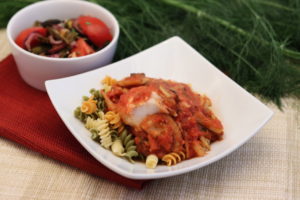 Fennel is absolutely delicious served raw or cooked. It tastes crisp and refreshing when added raw to salads and tastes tender and sweet when cooked and added to a variety of dishes.
Fennel is absolutely delicious served raw or cooked. It tastes crisp and refreshing when added raw to salads and tastes tender and sweet when cooked and added to a variety of dishes.
It’s very easy to cook with and can be roasted, sautéed, or grilled. The stalks can be incorporated into stocks, soups or stews. The leaves (or fronds) have a mild taste and you can chop them and enjoy them on salads or use them as garnishes, similar to how you would use fresh herbs.
To prepare it:
- Clean the bulb to remove any dirt or debris.
- Then, cut a small part of the bottom to get a stable base. You can then cut straight down to slice the bulb in half or into quarters. If the outer layers are bruised or wilted, you can peel those away if desired.
- Finally, you can lay the bulb down and slice it crosswise to your desired thickness. Many recipes call for thin slices, but it really depends on what you are making and your personal preferences.
What about fennel seeds?
 The fennel seeds are considered the dried fruit of the fennel plant. When a fennel plant passes maturity, it flowers, and then when the flowers die, seeds form in clumps. Fennel seeds are oval shaped and green or greenish brown in color. Bright green fennel seeds are best and are generally the freshest and highest quality. You will often see fennel seeds used to flavor breads, sausages and curry dishes.
The fennel seeds are considered the dried fruit of the fennel plant. When a fennel plant passes maturity, it flowers, and then when the flowers die, seeds form in clumps. Fennel seeds are oval shaped and green or greenish brown in color. Bright green fennel seeds are best and are generally the freshest and highest quality. You will often see fennel seeds used to flavor breads, sausages and curry dishes.
Fennel seeds can also help with digestion and can relieve bloating and fluid retention. You may notice a very slight licorice taste that can be more prominent in fennel seeds, more so than in fresh fennel.
Chew fennel seeds after a meal? Some say doing this can help prevent gas and indigestion! And ditch the after-dinner mint…chewing fennel seeds can also help freshen your breath and take away the smell and taste of garlic! You will sometimes see a bowl of fennel seeds when you leave an Indian restaurant…now you know why!
Here are a few fantastic ideas to add fennel to your REAL food routine:
 Garlic Parmesan Fennel Pizza
Garlic Parmesan Fennel Pizza- Cod with Tomato and Caramelized Fennel
- Fennel and Leek Al Forno
- Roasted Fennel, Chickpeas and Kale
- French-Inspired Fish and Fennel Skillet
- Fennel and Apple Salad with Blue Cheese
- Roasted Tomato, White Fish and Fennel
- Fennel Salad with Orange Mint Vinaigrette
- Creamy Cucumber and Fennel Salad
- One-Pot Chicken with Artichokes and Fennel
- Grilled Fennel Orzo Salad
- Roasted Fennel and Grapefruit Salad
Go ahead and try fennel in different ways — try it once a week during the month of May!
And please share your results with us!
If you want to read more on anethole and cancer:
 LEARN MORE ABOUT THE NAPKIN!
LEARN MORE ABOUT THE NAPKIN!
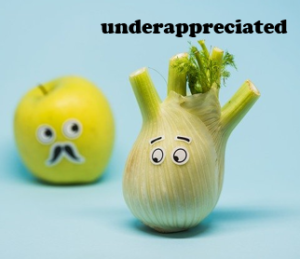
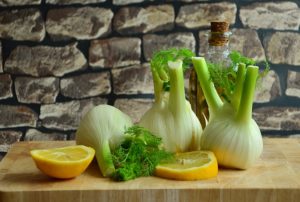
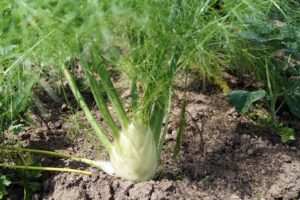

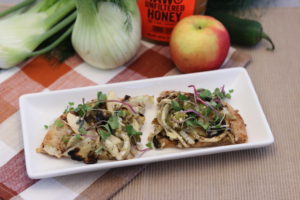
Leave A Comment